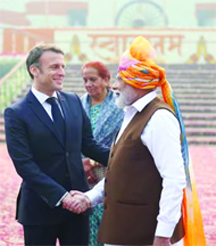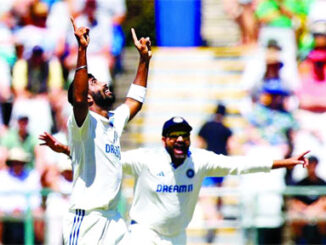
New Delhi (TIP) – India and France have agreed to a new road map for defence industrial cooperation to identify opportunities for partnership in the sector including co-designing, co-development and co-production of military hardware, the two countries will jointly produce a multi-mission helicopter in India, and French engine maker Safran is willing to transfer 100% technology to build fighter jet engines in the country, top officials said on Friday, January 26, a day after Prime Minister Narendra Modi and French President Emmanuel Macron held extensive talks to deepen strategic ties.
The two counties have also reached agreements on defence space partnership, satellite launches, joint research in clean energy, health care cooperation, collaboration in the field of public administration, and activation of five-year validity of Schengen visas for Indian students pursuing their Master’s degree in France, foreign secretary Vinay Kwatra said, briefing the media on the outcome of the talks between the two leaders.
Tata and Airbus Helicopters will partner to produce the H125 helicopters in India with a significant indigenous and localisation component, he said.
This will be India’s first helicopter assembly line in the private sector under the government’s “Make in India” initiative. The production of the first made-in-India H125 helicopter is expected to commence in 2026, people aware of the matter said. The helicopter can carry up to six passengers.
“The two countries have agreed to adopt the defence production road map. The priority of defence cooperation through this road map is to actually identify opportunities for partnership in the defence industrial sector that prioritise co-designing, co-development, co-production and also building the defence supply chains between the two countries so that they cannot only fulfil the defence needs of India and France but also can be a useful contributor to the security partnership with other countries who might be in use of similar products,” Kwatra said, in response to a question. Elaborating on the scope of the cooperation, he said it will encompass both air and space technologies, maritime technology including underwater domain awareness, equipment and systems related to land warfare, robotics, artificial intelligence, autonomous vehicles and platforms, and cyber defence.
“This flows from what the two countries agreed to in the Horizon 2047 Roadmap last year…The focus is on defence production and manufacturing in a manner that you can harness the compatibilities and competencies which the two economies have and the two engineering systems have and then use it to further strengthen your defence cooperation.”
Macron’s visit seeks to consolidate the ambitious renewal of the India-France strategic partnership that the two leaders decided on in Paris last July through the Horizon 2047 Roadmap. The French President’s visit has been very heavy in terms of its substantive outcome as well as the richness of discussions between the two leaders, he said.
France could step in to help India design and develop fighter jet engines.
On the Safran engine for India’s fighter jet programme, India’s ambassador to France Jawed Ashraf, who was present at the briefing, said, “The issue is really about arriving at a set of specifications that comply with our future fighter jet requirements. So this always features in the conversation between the President and the PM because what we are looking for is not just a manufacturing transfer of technology which essentially keeps you going with the same crutches that you have been going on for the last six decades.





Be the first to comment